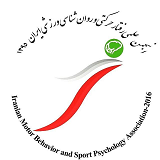Thu, Apr 25, 2024
[Archive]
Volume 1, Issue 1 (8-2019)
IJMCL 2019, 1(1): 43-52 |
Back to browse issues page
Download citation:
BibTeX | RIS | EndNote | Medlars | ProCite | Reference Manager | RefWorks
Send citation to:



BibTeX | RIS | EndNote | Medlars | ProCite | Reference Manager | RefWorks
Send citation to:
Hasan Barani F, Tahmasebi Boroujeni S, Ghods Mirheidari S B. (2019). Nonlinear Movement Anticipation Test with Specific Skills in Badminton Sport: Studying Based on Ecological Psychology Approach. IJMCL. 1(1), 43-52. doi:10.29252/ijmcl.1.1.66
URL: http://ijmcl.com/article-1-33-en.html
URL: http://ijmcl.com/article-1-33-en.html
Associate Professor, Department of Motor Behaviour, Faculty of Sport Sciences, University of Tehran, Tehran, Iran , shahzadtahmaseb@ut.ac.ir
Abstract: (3578 Views)
Objective: The aim of the present study was to investigate the nonlinear movement anticipation test with two specific skills in badminton sport based on an ecological psychology approach.
Methods: 20 young men, 10 members of Tehran Youth Badminton Team and 10 physical education students who just passed the badminton-1 course participated in two coincidence anticipation timing tests. The tests included performing one coincidence anticipation-timing task with the same conditions in service and drop skills. For data analysis, two independent and two dependent't' tests were used with the adjusted significance level (P≤0.025).
Results: Statistical analysis results indicated that there was a significant difference between drop and service tests (P≤0.025).
Conclusion: Finally, specific-skilled programs were suggested for badminton coaches in increasing coincidence anticipation timing accuracy in athletes.
Methods: 20 young men, 10 members of Tehran Youth Badminton Team and 10 physical education students who just passed the badminton-1 course participated in two coincidence anticipation timing tests. The tests included performing one coincidence anticipation-timing task with the same conditions in service and drop skills. For data analysis, two independent and two dependent't' tests were used with the adjusted significance level (P≤0.025).
Results: Statistical analysis results indicated that there was a significant difference between drop and service tests (P≤0.025).
Conclusion: Finally, specific-skilled programs were suggested for badminton coaches in increasing coincidence anticipation timing accuracy in athletes.
Type of Study: Original Article |
Subject:
1. Motor learning
Received: 2019/05/1 | Accepted: 2019/07/20
Received: 2019/05/1 | Accepted: 2019/07/20
References
1. Abdoli, Farsi, & Rmezanzadeh. ( 2012). The effect of increasing and decreasing contextual interference with the change motor program and parameter on the task anticipation timing coincidence learning and error detection capability. Journal of Motor Behavior (in persian)(13), 29-44.
2. Ak, E., & Koçak, S. (2010). Coincidence-anticipation timing and reaction time in youth tennis and table tennis players. Perceptual and motor skills, 110(3), 879-887. [DOI:10.2466/pms.110.3.879-887]
3. Akpinar, S., Devrilmez, E., & Kirazci, S. (2012). Coincidence-anticipation timing requirements are different in racket sports. Perceptual and motor skills, 115(2), 581-593. [DOI:10.2466/30.25.27.PMS.115.5.581-593]
4. Alder, D., Ford, P. R., Causer, J., & Williams, A. M. (2014). The coupling between gaze behavior and opponent kinematics during anticipation of badminton shots. Human movement science, 37, 167-179. [DOI:10.1016/j.humov.2014.07.002]
5. Davids, K. W., Button, C., & Bennett, S. J. (2008). Dynamics of skill acquisition: A constraints-led approach: Human Kinetics.
6. Downey, J., & Ross, L. (1982). Winning badminton singles: EP Publishing.
7. Duncan, M., Smith, M., & Lyons, M. (2013). The effect of exercise intensity on coincidence anticipation performance at different stimulus speeds. European journal of sport science, 13(5), 559-566. [DOI:10.1080/17461391.2012.752039]
8. Hagemann, N., Strauss, B., & Cañal-Bruland, R. (2006). Training perceptual skill by orienting visual attention. Journal of Sport and Exercise Psychology, 28(2), 143. [DOI:10.1123/jsep.28.2.143]
9. Hasan Barani, F., Abdoli, B., & Farsi, A. (2014). Effect of errorless and errorful learning on performance kinematic parameters in a throwing task: A pilot study. Journal of Research in Rehabilitation Sciences, 9(6).
10. Houmourtzoglou, E., Kourtessis, T., Michalopoulou, M., & Derri, V. (1998). Differences in several perceptual abilities between experts and novices in basketball, volleyball and water-polo. Perceptual and motor skills, 86(3), 899-912. [DOI:10.2466/pms.1998.86.3.899]
11. Jackson, R. C., & Mogan, P. (2007). Advance visual information, awareness, and anticipation skill. Journal of motor behavior, 39(5), 341-351. [DOI:10.3200/JMBR.39.5.341-352]
12. Keith, D., Chris, B., & J, B. S. (2008). Dynamics of skill acquisition: A constraints-led approach: Human Kinetics.
13. Meyers, L. S., Gamst, G., & Guarino, A. J. (2006). Applied multivariate research: Design and interpretation: Sage.
14. Mori, S., Ohtani, Y., & Imanaka, K. (2002). Reaction times and anticipatory skills of karate athletes. Human movement science, 21(2), 213-230. [DOI:10.1016/S0167-9457(02)00103-3]
15. Nuri, L., Shadmehr, A., Ghotbi, N., & Attarbashi Moghadam, B. (2013). Reaction time and anticipatory skill of athletes in open and closed skill-dominated sport. European journal of sport science, 13(5), 431-436. [DOI:10.1080/17461391.2012.738712]
16. Ripoll, H., & Latiri, I. (1997). Effect of expertise on coincident-timing accuracy in a fast ball game. Journal of sports sciences, 15(6), 573-580. [DOI:10.1080/026404197367001]
17. Robyn, K., Genevieve, N., & Kuba, G. (2013). Development of coincidence-anticipation timing in a catching task. Perceptual & Motor Skills, 117(1), 319-338. [DOI:10.2466/10.23.PMS.117x17z9]
18. Savelsbergh, G. J., Williams, A. M., Kamp, J. V. D., & Ward, P. (2002). Visual search, anticipation and expertise in soccer goalkeepers. Journal of sports sciences, 20(3), 279-287. [DOI:10.1080/026404102317284826]
19. Shim, J., Carlton, L. G., Chow, J. W., & Chae, W.-S. (2005). The use of anticipatory visual cues by highly skilled tennis players. Journal of motor behavior, 37(2), 164-175. [DOI:10.3200/JMBR.37.2.164-175]
20. Vänttinen, T., Blomqvist, M., Luhtanen, P., & Häkkinen, K. (2010). Effects of age and soccer expertise on general tests of perceptual and motor performance among adolescent soccer players. Perceptual and motor skills, 110(3), 675-692. [DOI:10.2466/pms.110.3.675-692]
21. Williams, A. M., & Starkes, J. (2002). Cognitive expertise and performance in interceptive actions. Interceptive actions in sport: Information and movement, 40.
Send email to the article author
| Rights and Permissions | |
 |
This work is licensed under Attribution 4.0 International (CC BY 4.0). |












